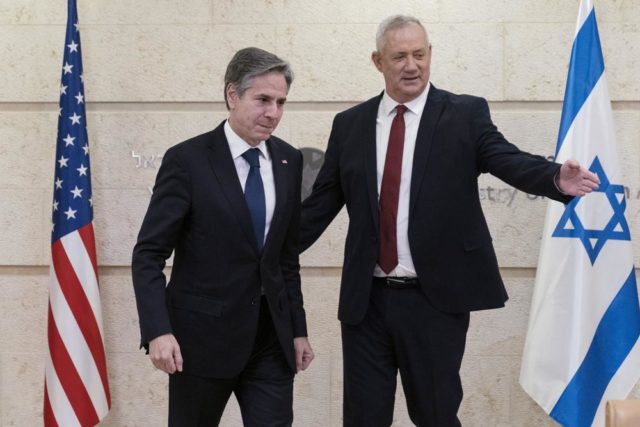
Video has emerged of Palestinians fighting on the grounds of the Temple Mount in Jerusalem, also known as the Al-Aqsa Mosque compound. The AP reported that only hours after the ceasefire with Israel took effect, thousands of Hamas supporters demonstrated against the Palestinian Authority (PA) and the rule of Mahmoud Abbas in the West Bank, chanting, “Dogs of the Palestinian Authority, out, out. The people want the president to leave.” Violence quickly ensued.
This is a glimpse of Palestinian politics that President Joe Biden and Secretary of State Antony Blinken should take seriously as they discuss reconstruction in Gaza. The Hamas rocket war on Israel owed much to the Hamas-Fatah civil war that began in 2007 and has simmered since then, with Hamas in control of Gaza and Fatah in control of the West Bank. Each is a dictatorship. In the run-up to a planned 2021 Palestinian election, Abbas stoked violence against Israel, claiming that Al-Aqsa was under siege and Israel was committing “ethnic cleaning.” Abbas, apparently, feared he might lose the election to Hamas—so he canceled it and blamed Israel.
PA television was full of speeches and music videos promising glory for those who killed Jews. A music video was repeatedly broadcast in which Palestinians declared, “I fired my shots, I threw my bomb, I detonated, detonated, detonated my [explosive] belts. …My brother, throw my blood on the enemy like bullets.” Abbas’ religious affairs advisor told viewers, “Islam does not want you to be submissive to others,” and “if you die fighting, you go to paradise; if you kill the enemies, they go to hell.”
And when the election was canceled, Hamas rushed forward—flags flying in Jerusalem (an oddity) and taking credit for the violence. Then came the Hamas rockets and Israel’s response. Since the ceasefire, Hamas has been claiming its victory in Fatah territory as well as in Gaza. It is an easier sell on the West Bank; residents of Gaza actually know Hamas fired from among them into Israel and know a percentage of Hamas’ rockets fell in Gaza itself.
Here is the point for the administration—Biden says he absolutely will not allow Hamas to be in charge of reconstruction in Gaza. “The United States is committed to…provid[ing] rapid humanitarian assistance and to marshal[ing] international support for the people of Gaza and Gaza reconstruction efforts. We will do this in full partnership with the Palestinian Authority—not Hamas, the Authority—in a manner that does not permit Hamas to simply restock its military arsenal.”
Blinken told CNN, “We have to find a way to break the cycle, because if we don’t, it will repeat itself at great cost and at great human suffering on all sides. …We’ll be re-engaging with the Palestinians, of course, continuing our deep engagement with the Israelis, and trying to put in place conditions that allow us over time hopefully to advance a genuine peace process.”
The administration is bolstered from the outside by veteran “peace processer” Dennis Ross, who urged the international community to link humanitarian aid to Hamas demilitarization. A “mechanism would be needed to ensure that humanitarian assistance to Gaza was not diverted to Hamas for the reconstruction of its rocket arsenal.” Who would actually do the demilitarization is unclear.
The Washington Institute’s Rob Satloff made essentially the same proposal, but bigger: “The most effective Gaza monitoring system would be a new civilian unit of technical, developmental, engineering and border-control experts modeled on the Multilateral Force & Observers [MFO] in the Sinai—that is, a U.S.-organized and -led international body with contingents from a number of friendly countries. Such an entity would be able to inspect where it pleases, operate an import licensing system with speed and efficiency, and have the backbone to suspend imports if it discovered diversions.”
Reminder to both Ross and Satloff: The Sinai MFO comprises military forces, American and others. Are they suggesting that the U.S. lead a military intervention in Gaza?
The dose of reality they all need may be coming from the international donor community, long presumed to simply turn on the spigot when asked. But in recent discussions, Kan News Service wrote, “Regarding the question of whether and how much money to donate to Gaza for aid.. sources in those countries expressed frustration…that the money was being transferred to Gaza ‘without real oversight capability and without a broader political-political process.’ …Since 2014, donor countries, mainly European ones, have invested more than $2 billion in rehabilitating the Gaza Strip.”
If donors are hesitant, Israeli Defense Minister Benny Gantz is pessimistic. “I’m not naïve; some of the materials we let in will go to Hamas. In the end, it’s complicated. You need cement to build, and some of it goes to the terror tunnels.”
If the United States and other donors plan to finance Gaza reconstruction, three things should be kept in mind. First, Hamas is unlikely to peaceably turn over its arsenal to anyone—and least likely to turn it over to its chief rival, the PA. Second, although for the moment Fatah may appear to be the lesser of two evils, it is still evil. And third, in discussing the situation in Gaza, the most pessimistic voice is usually the most realistic one.

